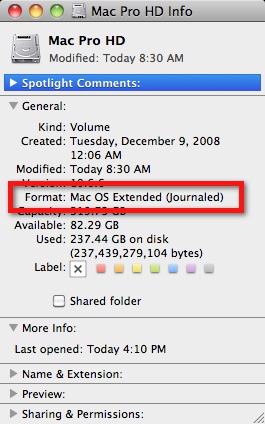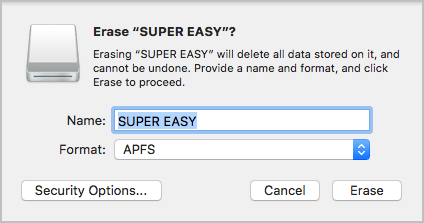Oct 03, 2017 I am guessing its because my external drives are formatted using 'mac os extended journaled' and not 'APFS'? First time I've ever downgraded my operating system. EugW macrumors G3. Jun 18, 2017 8,262 5,636. Oct 3, 2017 #6 All of my external HFS+ Journaled drives work perfectly, and I have many of them. My boot SSD is APFS with. HFS+ vs APFS Up until recently, HFS+ was the only file system supported by macOS and OS X. However, with the launch of the newest macOS High Sierra, Apple introduced a new drive type called Apple File System (APFS). HFS+ HFS+ was first introduced in 1998 with the launch of Mac OS 8.1 back when Apple made the switch to Intel-based processors. Although HFS+ is supported on all versions of Mac. Mar 15, 2018 To use HFSExplorer, connect your Mac-formatted drive to your Windows PC and launch HFSExplorer. Click the “File” menu and select “Load File System From Device.” It will automatically locate the connected drive, and you can load it. You’ll see the contents of the HFS+ drive.
The most common format for a Time Machine backup disk is Mac OS Extended format (Journaled) format, but Time Machine also supports Mac OS Extended (Case-sensitive, Journaled) and Xsan formats. Important: You can back up from an HFS+ or APFS-formatted disk to an HFS+ disk; however, Time Machine can’t back up to an APFS-formatted disk. Some of these devices will still work with your Mac out of the box, but you're better off formatting the drive yourself to use a Mac-specific file system like Mac OS Extended (Journaled) or a format that works across platforms like ExFat. We’ll select Mac OS Extended (Journaled), which is the “old” HFS+ format, then click the Erase button. Looking at the container after the Erase is completed, we see that the drive is indeed using the Mac OS Extended (Journaled) HFS+ format. Our drive is now formatted as HFS+ (Mac OS Extended (Journaled)).
Are you having trouble creating Mac OS Extended (Journaled) and APFS partitions using Disk Utility? If so, you can create a Mac OS Extended partition using GParted, then convert to APFS using Disk Utility.Disk Utility
Disk Utility is a disk utility on macOS operating system. It supports creating, splitting, merging, resizing, deleting and formatting partitions on the hard disk. Disk Utility only supports partition creation and formatting for Mac OS Extended (Journaled), exFAT, MS-DOS (FAT) and since MacOS High Sierra (10.13), it supports APFS.
If you are a Linux user or operating systems other than macOS, you probably use another tool. In another case, if you are using a Seagate, WD My Passport or any other hard drive that you previously partitioned with another tool. Disk Utility will report MediaKit reports not enough space on device for requested operation. This error occurs because the partitions created do not comply with Apple’s partition policy. In this case, you can use other tools instead of Disk Utility.
In this article, I will guide you to create a Mac OS Extended (Journaled) partition with GParted. If you want to install macOS High Sierra or later versions, just use the Convert to APFS feature on Disk Utility.
GParted

GParted is a well known disk partitioning program. It supports many partition formats such as FAT32, NTFS, exFAT, Ext4 and of course supports Mac OS Extended. We can use GParted to create Mac OS Extended partitions in just a few simple steps.
GParted comes pre-installed on many Linux distributions like Ubuntu, Debian, Linux Mint… If you already have GParted installed, just use it. If not, you can download GParted or 4MParted ISO files then integrate into AIO Boot. You should use these two operating systems, as they have pre-installed programs that support the format. If you use GParted on Ubuntu, Linux Mint or Debian, you need to install hfsprogs.

The format of Mac OS Extended is HFS+. There are some commercial softwares that support creating HFS + partitions on Windows, but GParted is free. Now we will create the HFS+ partition with GParted.
- Run GParted and select the hard disk in the dropdown list at the top right. My hard disk is /dev/sda.
- You can only create new partitions if your hard disk has unallocated space. Right-click on the unallocated space and select New. You can also format existing partitions to HFS+. Right-click the existing partition, select Format to, and then select hfs+. Or delete the existing partition to recreate it.
- Select hfs+ in the File system. Then select and enter some information for the other items you want.
- Click Add, then click Apply to apply the changes.
The Mac OS Extended partition created by GParted will not be journaled. However, we can use Disk Utility to Enable Journaling. Or use the following command to format Mac OS Extended to Mac OS Extended (Journaled):
/dev/sdaX Samsung usb driver for mac os. is the partition you want to format.
Convert to APFS
From the MacOS High Sierra version, Apple announced a new file system called APFS. By default, macOS High Sierra can only be installed on an APFS partition. You can use Disk Utility to convert Mac OS Extended partitions to APFS without losing data.
If the Mac OS Extended partition is not Journaled, please journaled it first. Run Disk Utility, select the Mac OS Extended partition in the left column, then select File and select Enable Journaling.
Now you can convert Mac OS Extended (Journaled) partitions to APFS without losing data. Just select Edit and select Convert to APFS…
The easiest, most reliable and best way to write to NTFS drive in macOS High Sierra is by using third party software. However, the last two can fail and require too much work. Now, some files seem to have their permissions messed up. How to read ntfs on mac. So I’m referring to the fstab trick that worked like a charm before High Sierra.
Moreover, Studio One integrates tightly with PreSonus interfaces, configuring automatically—no need to map inputs and outputs. Presobus Check out stories about tours by PreSonus artists, love letters and videos from customers, and more. Presonus audiobox usb setup.
By using GParted with the simple steps above, we can easily create Mac OS Extended (Journaled) partitions and many other formats that Disk Utility does not support. If you need to create macOS High Sierra bootable USB from Windows, you can try Clover Boot Disk. Good luck!

System Drive Formatted With Journaled Hfs+ Mac Os Extended Journaled Encrypted
Back in December of 2018 when APFS was brand-new in macOS 10.14 Mojave, The Rocket Yard featured an article showing the rather arduous method of reverting an APFS (Apple File System) drive to the older HFS+ format. One of the commenters on that original post pointed out a few months ago that it’s now possible to perform the APFS to HFS+ conversion without all of the steps, and that’s what this article will show you how to do.
System Drive Formatted With Journaled Hfs+ Mac Os Extended Journaled
The drive I’ll convert is a 2TB mobile USB-C hard disk. If we launch Applications > Utilities > Disk Utility, we see that the drive is currently set up with APFS:
Previously, there was no easy way to do the conversion other than to fire up Terminal and enter a bunch of arcane commands. If I were to try to erase this external volume, the only format that appears is APFS. What do we do?
Here’s the trick. See that “View” button in the upper left corner of the Disk Utility window (screenshot above)? Click it, and you have a choice of viewing only volumes (the default) or all devices. Select Show All Devices, and the left sidebar changes a bit:
We can now see the APFS container on the external drive volume. To reformat our drive as HFS+, we need to click on “Container disk3” (or whatever your APFS container is named) to select it, then click the Erase button in the Disk Utility toolbar. As you can see when you click the Format pop-up menu, there are many choices available other than APFS:
System Drive Formatted With Journaled Hfs+ (mac Os Extended Journaled)
We’ll select Mac OS Extended (Journaled), which is the “old” HFS+ format, then click the Erase button. Looking at the container after the Erase is completed, we see that the drive is indeed using the Mac OS Extended (Journaled) HFS+ format.
System Drive Formatted With Journaled Hfs+ (mac Os Extended Journaled) File System
Many thanks to commenter smayer97 for pointing out that the Disk Utility in macOS 10.15 Catalina provides the ability to easily reformat an APFS drive as HFS+.System Drive Formatted With Journaled Hfs+ Mac Os Extended Journaled Vs Exfat
Be Sociable, Share This!
OWC is on-site wind turbine powered at 8 Galaxy Way, Woodstock, IL 60098 | 1-800-275-4576 | +1-815-338-8685 (International)
All Rights Reserved, Copyright 2018, OWC – Since 1988